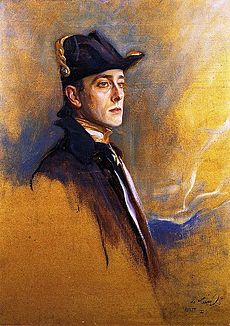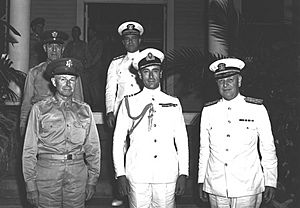Louis Mountbatten, 1st Earl Mountbatten of Burma facts for kids
Quick facts for kids
The Earl Mountbatten of Burma
|
|
|---|---|
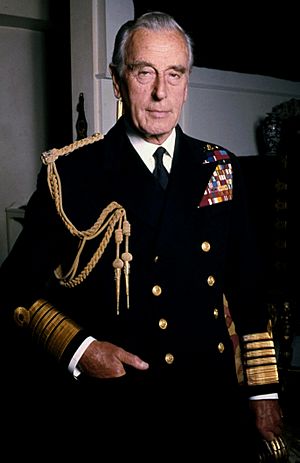
Portrait by Allan Warren, 1976
|
|
| Chief of the Defence Staff | |
| In office 13 July 1959 – 15 July 1965 |
|
| Prime Minister | |
| Preceded by | Sir William Dickson |
| Succeeded by | Sir Richard Hull |
| First Sea Lord | |
| In office 18 April 1955 – 19 October 1959 |
|
| Prime Minister | |
| Preceded by | Sir Rhoderick McGrigor |
| Succeeded by | Sir Charles Lambe |
| Governor-General of India | |
| In office 15 August 1947 – 21 June 1948 |
|
| Monarch | George VI |
| Prime Minister | Jawaharlal Nehru |
| Preceded by | Himself (As Viceroy and Governor-General) |
| Succeeded by | C. Rajagopalachari |
| Viceroy of British India | |
| In office 21 February 1947 – 15 August 1947 |
|
| Monarch | George VI |
| Prime Minister | Clement Attlee |
| Preceded by | The Viscount Wavell |
| Succeeded by |
|
| Member of the House of Lords | |
| Hereditary peerage 13 June 1946 – 27 August 1979 |
|
| Preceded by | Peerage established |
| Succeeded by | The 2nd Countess Mountbatten of Burma |
| Personal details | |
| Born |
Prince Louis of Battenberg
25 June 1900 Frogmore House, Windsor, Berkshire, England |
| Died | 27 August 1979 (aged 79) Mullaghmore, County Sligo, Ireland |
| Cause of death | Assassination |
| Resting place | Romsey Abbey |
| Spouse |
Edwina Ashley
(m. 1922; died 1960) |
| Children | |
| Parents |
|
| Alma mater | Christ's College, Cambridge |
| Military service | |
| Allegiance | United Kingdom |
| Branch/service | Royal Navy |
| Years of service | 1913–1965 |
| Rank | Admiral of the Fleet |
| Commands |
See list
(1959–1965) First Sea Lord
(1955–1959) Mediterranean Fleet
(1952–1954) (1950–1952) (1943–1946) Chief of Combined Operations
(1941–1943) HMS Illustrious
(1941) HMS Kelly
(1939–1941) HMS Wishart
(1934–1936) HMS Daring
(1934) |
| Battles/wars | |
| Awards | See list |
Louis Francis Albert Victor Nicholas Mountbatten, 1st Earl Mountbatten of Burma (25 June 1900 – 27 August 1979) was a British naval officer and important leader. He was a close relative of the British royal family. Born in the United Kingdom, Mountbatten was a maternal uncle of Prince Philip, Duke of Edinburgh. He was also a second cousin of King George VI.
Mountbatten joined the Royal Navy during the First World War. In the Second World War, he became the Supreme Allied Commander for South East Asia Command. After the war, he served as the last Viceroy of British India. He was also the first Governor-General of the new Dominion of India for a short time.
Mountbatten went to the Royal Naval College, Osborne. He joined the Royal Navy in 1916. He fought in the last part of the First World War. After the war, he studied briefly at Christ's College, Cambridge. Between the two World Wars, Mountbatten continued his naval career. He became an expert in naval communications.
Contents
A Life of Service
Mountbatten, then known as Prince Louis of Battenberg, was born on 25 June 1900. His birthplace was Frogmore House in Windsor, Berkshire. He was the youngest child of Prince Louis of Battenberg and Princess Victoria of Hesse and by Rhine. His maternal grandparents were Louis IV, Grand Duke of Hesse, and Princess Alice of the United Kingdom. Princess Alice was a daughter of Queen Victoria.
Mountbatten was baptized on 17 July 1900. His godparents included Queen Victoria. His family nickname was "Dickie." This was to avoid confusion with other "Nickys" in the Russian Imperial Family. He was educated at home until he was 10. Then he went to Lockers Park School. In May 1913, he joined the Royal Naval College, Osborne.
During World War I, Britain was at war with Germany. To show support for Britain, the royal family changed its name. King George V changed the name of the British royal house to the House of Windsor. Mountbatten's father also changed his German name. He adopted the surname Mountbatten. He was later given the title Marquess of Milford Haven.
In July 1916, Mountbatten became a midshipman on HMS Lion. He later moved to HMS Queen Elizabeth. In June 1917, he became known as Lord Louis Mountbatten. This was a courtesy title. He visited the Western Front in July 1918.
He was appointed first lieutenant of HMS P. 31 in October 1918. In January 1919, he became a sub-lieutenant. Mountbatten attended Christ's College, Cambridge, for two terms. He studied English literature there. He was promoted to lieutenant in April 1920.
In March 1920, Mountbatten joined HMS Renown. He went on a royal tour of Australia with Edward, Prince of Wales. He then transferred to HMS Repulse in March 1921. He accompanied the Prince of Wales on another royal tour. This trip was to India and Japan. Edward and Mountbatten became close friends.
Mountbatten was interested in new technology. He joined the Portsmouth Signals School in August 1924. He studied electronics at the Royal Naval College, Greenwich. He became an expert in naval communications. In January 1927, he became Assistant Fleet Wireless and Signals Officer. He was promoted to lieutenant-commander in April 1928. In December 1932, he was promoted to commander.
In 1934, Mountbatten received his first command. It was the destroyer HMS Daring. He later commanded HMS Wishart. He was appointed a personal naval aide-de-camp to King Edward VIII in June 1936. He was promoted to captain in June 1937. In June 1939, he was given command of the destroyer HMS Kelly.
World War II Leadership
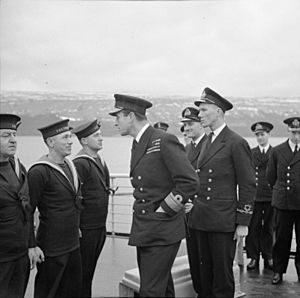
When World War II began in September 1939, Mountbatten commanded the 5th Destroyer Flotilla. His ship, HMS Kelly, became well-known. In May 1940, Mountbatten led a British convoy. They evacuated Allied forces during the Norwegian Campaign.
HMS Kelly was torpedoed in May 1940. Mountbatten then commanded from HMS Javelin. He rejoined Kelly in December 1940. However, Kelly was sunk by German dive bombers in May 1941. This happened during the Battle of Crete. Mountbatten was recognized for his bravery. He received the Distinguished Service Order.
In August 1941, Mountbatten became captain of the aircraft carrier HMS Illustrious. He visited Pearl Harbor before the Japanese attack. He was concerned about the base's lack of readiness.
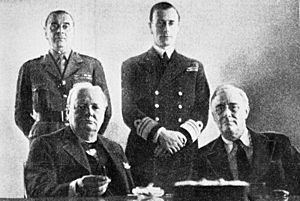
In October 1941, Mountbatten became Chief of Combined Operations Headquarters. He was promoted to commodore. In this role, he helped invent new ways to assist with landings. His team developed underwater oil pipelines and artificial harbors. They also created special tank-landing ships.
As commander of Combined Operations, Mountbatten planned the successful Bruneval raid. This raid captured important German radar equipment in February 1942. He was promoted to acting rank of vice admiral in March 1942. He also helped plan the St Nazaire Raid in March 1942. This raid disabled a key German dock.
The Dieppe Raid in August 1942 was a failure. Many Allied soldiers, mostly Canadians, were lost. Mountbatten stated that lessons from Dieppe were vital for planning the later D-Day invasion. As a result of Dieppe, the British created specialized armored vehicles. These vehicles saved many lives during the Normandy Landings.
In August 1943, Winston Churchill appointed Mountbatten as Supreme Allied Commander. This was for the South East Asia Command (SEAC). He was promoted to acting full admiral. His command oversaw the recapture of Burma from the Japanese.
A major moment was the Japanese surrender in Singapore. British troops returned to the island in September 1945. They received the formal surrender of Japanese forces. South East Asia Command was closed in May 1946. Mountbatten returned home as a rear-admiral. For his war service, he was made a Knight of the Garter. He was also given the title Viscount Mountbatten of Burma in 1946. In 1947, he became Earl Mountbatten of Burma.
Overseeing India's Independence
In March 1947, Mountbatten was appointed Viceroy of India. His job was to oversee India's transition to independence. This was to happen by June 1948. Mountbatten's goal was to keep India united. However, he was allowed to adapt if the situation changed. He arrived in India in March 1947. Soon after, large riots broke out.
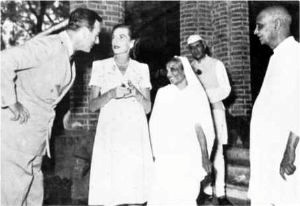
Mountbatten quickly realized the situation was very unstable. He decided independence needed to happen sooner. He believed waiting longer would lead to civil war. He also wanted to return to his naval career.
Mountbatten had a good relationship with Congress leader Jawaharlal Nehru. He found the Muslim League leader Muhammad Ali Jinnah to be very determined. Jinnah insisted on a separate Muslim state called Pakistan.
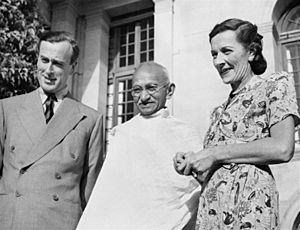
Given the urgent need for independence, Mountbatten concluded that a united India was not possible. He accepted the plan to divide India. This created the independent nations of India and Pakistan. Mountbatten set the date for independence as 15 August 1947. This fixed timeline was meant to show Britain's commitment.
A committee drew the new borders for India and Pakistan. This division caused about 14 million people to move. They fled to what they hoped would be safety on the other side of the new borders.
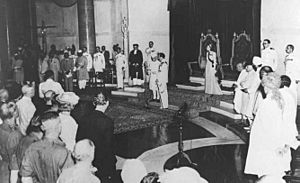
When India and Pakistan became independent, Mountbatten was still Viceroy. He remained in New Delhi for 10 months. He served as the first governor-general of independent India until June 1948. Mountbatten advised India to take the issue of Kashmir to the United Nations. This issue remains unresolved today.
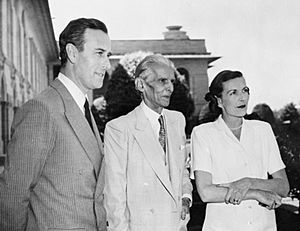
Mountbatten's role in India's independence is seen in different ways. Some believe he rushed the process too much. This may have contributed to the violence that followed. Others argue that Britain had no choice but to act quickly. They say Britain had limited resources after World War II.
Mountbatten did not support the idea of Pakistan. He had a close relationship with Nehru. The Pakistani government never forgave Mountbatten for his attitude towards Pakistan. They did not allow him to travel through their airspace later.
Post-India Career
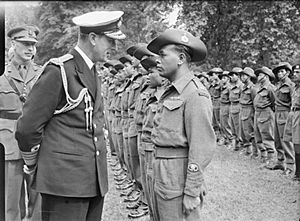
After India, Mountbatten commanded the 1st Cruiser Squadron. He was promoted to vice-admiral in June 1949. He became Second-in-Command of the Mediterranean Fleet in April 1950. In June 1950, he became Fourth Sea Lord at the Admiralty.
From June 1952, he served as Commander-in-Chief, Mediterranean Fleet. He was also NATO Commander Allied Forces Mediterranean. He was promoted to full admiral in February 1953. In March 1953, he became Personal Aide-de-Camp to the Queen.
Mountbatten's final posting was as First Sea Lord. He held this position from April 1955 to July 1959. His father had held the same position 40 years earlier. This was a unique achievement for a father and son. He was promoted to Admiral of the Fleet in October 1956.
During the Suez Crisis of 1956, Mountbatten advised Prime Minister Anthony Eden. He warned against seizing the Suez Canal. He believed it would harm Britain's global standing. His advice was not followed.
Mountbatten became concerned about nuclear weapons. He opposed their use in combat. However, he recognized the potential of nuclear energy. He wrote an article about the nuclear arms race after his death.
After leaving the Admiralty, Mountbatten became Chief of the Defence Staff. He held this role for six years. He helped combine the military's three service departments into one Ministry of Defence.
Mountbatten was appointed colonel of the Life Guards in January 1965. He also became Life Colonel Commandant of the Royal Marines. He was Governor of the Isle of Wight from 1965. Later, he became the first Lord Lieutenant of the Isle of Wight.
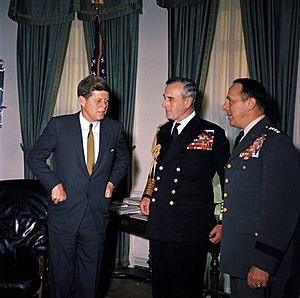
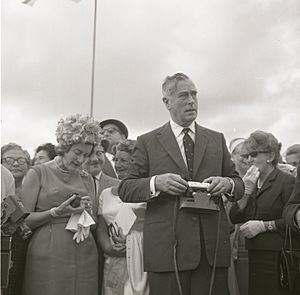
Mountbatten was elected a Fellow of the Royal Society. He received an honorary doctorate in 1968.
From 1967 to 1978, Mountbatten was president of the United World Colleges Organisation. He supported these colleges. He encouraged world leaders to share his interest. Under his leadership, new colleges were established in Singapore and Canada. In 1978, he passed the presidency to his great-nephew, the Prince of Wales.
Mountbatten also helped launch the International Baccalaureate. In 1971, he presented the first IB diplomas. In 1975, Mountbatten visited the Soviet Union. He led the UK delegation for Victory Day celebrations.
Personal Life and Family
Marriage and Daughters
Mountbatten married Edwina Cynthia Annette Ashley on 18 July 1922. She was the granddaughter of a wealthy magnate, Sir Ernest Cassel. She was the main heir to his fortune. The couple spent a lot on their homes and entertainment. They went on a honeymoon tour of Europe and America. This included a visit to Niagara Falls.
Lord and Lady Mountbatten had two daughters. They were Patricia Knatchbull (born 1924) and Lady Pamela Hicks (born 1929). Patricia was a lady-in-waiting to Queen Elizabeth II. Pamela accompanied her parents to India.
Since Mountbatten had no sons, his titles could pass to his daughters. This was arranged when he was made Viscount and then Earl.
Hobbies and Interests
Mountbatten loved genealogy. This is the study of family history. He shared this interest with other European royals. He spent much of his free time studying his links to royal families. From 1957 until his death, he was Patron of the Cambridge University Heraldic and Genealogical Society.
He was also very interested in military ranks and uniforms. He even took an interest in fashion design. He introduced new features like trouser zips. In 1949, he designed new flags and uniforms for the Indian Armed Forces. Many of his designs are still used today.
Like many royals, Mountbatten enjoyed polo. He even received a patent for a polo stick in 1931. He introduced polo to the Royal Navy in the 1920s. He also wrote a book about the sport. He was Commodore of Emsworth Sailing Club from 1931. He was also a long-serving Patron of the Society for Nautical Research.
Mentoring Prince Charles
Mountbatten was a significant influence on his grand-nephew, King Charles III. He was a mentor to Charles. They called each other "Honorary Grandfather" and "Honorary Grandson." Mountbatten sometimes advised Charles. He encouraged the Prince to enjoy his youth. He also advised him to marry a young and inexperienced girl. This was to ensure a stable marriage.
Mountbatten played a role in the first meeting of Charles's parents. He arranged for King George VI and Queen Elizabeth to visit Britannia Royal Naval College in 1939. He made sure Princess Elizabeth and Margaret were invited. He asked his nephew, Cadet Prince Philip of Greece, to entertain them. This was the first time Charles's future parents met.
In 1974, Mountbatten discussed a possible marriage for Charles. He suggested his granddaughter, Hon. Amanda Knatchbull. Charles wrote to Amanda's mother, Lady Brabourne. She was also his godmother. She supported the idea but felt her daughter was too young.
In February 1975, Charles visited New Delhi. Mountbatten showed him around the former Viceroy's House. Four years later, Mountbatten tried to arrange a trip to India for himself, Charles, and Amanda. However, their fathers objected. Charles was rescheduled to tour India alone. Mountbatten did not live to see this trip. When Charles proposed to Amanda later in 1979, she declined.
Television Appearances
On 27 April 1977, Mountbatten became the first member of the Royal Family to appear on the TV show This Is Your Life. Over 22 million people in the UK watched the program.
Assassination
Mountbatten often spent holidays at his summer home. This was Classiebawn Castle in Mullaghmore, County Sligo, Ireland. This village was close to the border with Northern Ireland. It was near an area used by IRA members.
On 27 August 1979, Mountbatten went fishing on his boat, Shadow V. An IRA member, Thomas McMahon, had placed a bomb on the boat. The bomb weighed 50 pounds. It was detonated when the boat was a few hundred yards from shore. The blast destroyed the boat.
Mountbatten, aged 79, was pulled from the water alive. However, he died from his injuries before reaching shore. Also on the boat were his elder daughter Patricia, Lady Brabourne, and her husband Lord Brabourne. Their twin sons Nicholas and Timothy Knatchbull were also there. Lord Brabourne's mother, Doreen, Dowager Lady Brabourne, and a young crew member named Paul Maxwell were also present.
Nicholas (aged 14) and Paul (aged 15) were killed by the explosion. The others were seriously injured. Doreen, Dowager Lady Brabourne (aged 83), died the next day from her injuries.
The attack caused widespread shock and sadness. The Queen received messages of sympathy from leaders around the world. These included US President Jimmy Carter and Pope John Paul II.
On the same day, the IRA also killed 18 British soldiers. This happened in Northern Ireland. It was the deadliest attack on the British Army during the Troubles.
Funeral and Aftermath
On 5 September 1979, Mountbatten received a ceremonial funeral. It was held at Westminster Abbey. The Queen, the royal family, and members of European royal houses attended. Thousands watched the funeral procession. It included military representatives from many countries. His coffin was carried by 118 Royal Navy sailors.
During the televised service, the Prince of Wales (later King Charles III) read from the Bible. The Archbishop of Canterbury spoke about Mountbatten's achievements. He highlighted his devotion to the Royal Navy. After the public ceremonies, Mountbatten was buried in Romsey Abbey.
Thomas McMahon was arrested and tried for the assassinations in Ireland. He was convicted in November 1979. Forensic evidence linked him to the bombing.
After Mountbatten's death, the Master of the Queen's Music, Malcolm Williamson, wrote a musical piece. It was called Lament in Memory of Lord Mountbatten of Burma.
Legacy
Mountbatten was a significant figure in British history. He supported nationalist movements. He believed people should control their own future. He aimed to maintain stable governments.
In 1984, the Mountbatten Institute was created. It allows young adults to experience other cultures. This helps them learn and grow. The IET annually awards the IET Mountbatten Medal. This medal recognizes contributions to electronics and information technology.
Canada's capital city, Ottawa, named Mountbatten Avenue in his memory. The Mountbatten area in Singapore and the Mountbatten MRT station are also named after him.
Mountbatten's personal papers are kept at the University of Southampton Library. They include many papers and photographs.
Awards and decorations
| Ribbon | Name | Date awarded |
|---|---|---|
| Knight of the Garter (KG) | 1946 | |
| Knight Grand Cross of the Order of the Bath (GCB) | 1955 | |
| Knight Commander of the Order of the Bath (KCB) | 1945 | |
| Companion of the Order of the Bath (CB) | 1943 | |
| Member of the Order of Merit (Military Division) (OM) | 1965 | |
| Knight Grand Commander of the Most Exalted Order of the Star of India (GCSI) | 1947 | |
| Knight Grand Commander of the Most Eminent Order of the Indian Empire (GCIE) | 1947 | |
| Knight Grand Cross of the Royal Victorian Order (GCVO) | 1937 | |
| Knight Commander of the Royal Victorian Order (KCVO) | 1922 | |
| Member of the Royal Victorian Order (MVO) | 1920 | |
| Companion of the Distinguished Service Order (DSO) | 1941 | |
| Knight of Justice of the Most Venerable Order of the Hospital of Saint John of Jerusalem (KStJ) | 1940 | |
| Commander of the Most Venerable Order of the Hospital of Saint John of Jerusalem (CStJ) | 1929 | |
| British War Medal | 1918 | |
| Victory Medal | 1918 | |
| 1939–45 Star | 1945 | |
| Atlantic Star | 1945 | |
| Africa Star | 1945 | |
| Burma Star | 1945 | |
| Italy Star | 1945 | |
| Defence Medal | 1945 | |
| War Medal 1939–1945 | 1945 | |
| Naval General Service Medal | ||
| King George V Coronation Medal | 1911 | |
| King George V Silver Jubilee Medal | 1935 | |
| King George VI Coronation Medal | 1937 | |
| Queen Elizabeth II Coronation Medal | 1952 | |
| Queen Elizabeth II Silver Jubilee Medal | 1977 | |
| Indian Independence Medal | 1949 | |
| Knight Grand Cross of the Order of Isabella the Catholic | ||
| Order of the Nile, Fourth Class | ||
| Knight Grand Cross of the Order of the Crown | ||
| Knight Grand Cross of the Order of the Star of Romania | ||
| War Cross | ||
| Chief Commander of the Legion of Merit | ||
| Special Grand Cordon of the Order of the Cloud and Banner | ||
| Distinguished Service Medal | ||
| Asiatic-Pacific Campaign Medal | ||
| Knight Grand Cross of the Order of the White Elephant | ||
| Grand Commander of the Order of the Star of Nepal | ||
| Grand Cross of the Legion of Honour | ||
| 1939–1945 War Cross | ||
| Knight Grand Cross of the Order of George I | ||
| Knight Grand Cross of the Order of the Netherlands Lion | ||
| Knight Grand Cross of the Order of Aviz | ||
| Knight of the Royal Order of the Seraphim | ||
| Grand Commander of the Order of Thiri Thudhamma | ||
| Grand Cross of the Order of the Dannebrog | ||
| Knight Grand Cross of the Order of the Seal of Solomon | ||
| Order of the Distinguished Rule of Izzuddin | ||
| King Birendra Coronation Medal |
He was appointed personal aide-de-camp by Edward VIII, George VI and Elizabeth II. This meant he could wear three royal symbols on his uniform.
Arms
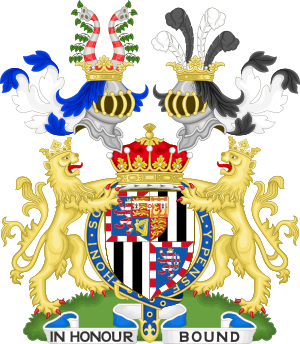 |
|
Images for kids
-
Mountbatten during his tour of the Arakan Front in Burma in February 1944
See also
 In Spanish: Luis Mountbatten para niños
In Spanish: Luis Mountbatten para niños


